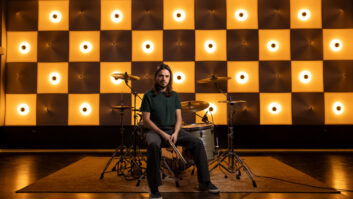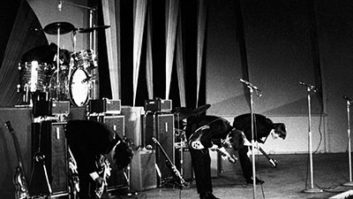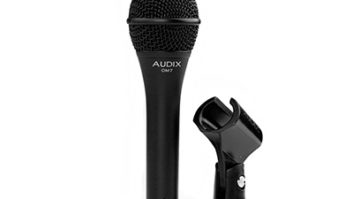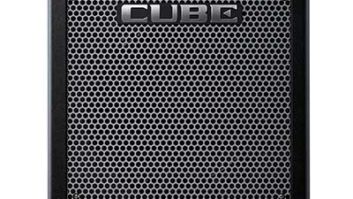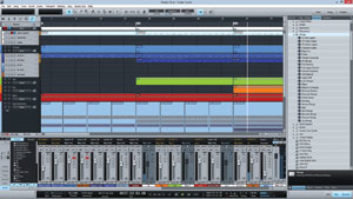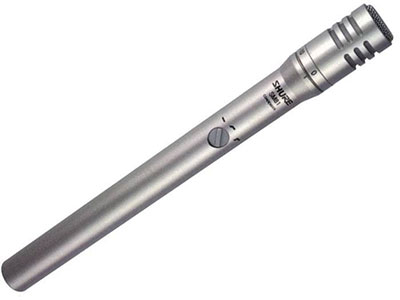
As subjectivity guides the practice of choosing the best microphone for the best sound source, preferences for specific models, as a rule, abound. However, the immediacy of live sound work begs for tools that are generally less specialized, working well on a wider range of sound sources; are impeccably built and more resistant to drop damage; and, we hope, are more affordable than those most often residing in climate-controlled, padded microphone lockers.
This month I share a variety of transducers that are no-brainer “workhorses” for the road, proven on the most common of backline sound sources (drums and speaker cabinets) as well as more specific tones, too (piano, horns, acoustic strings of many kinds, etc.). In the interest of focus, I have not included wireless and/or miniature microphones in this collection, choosing to highlight models most often placed on a stand or that feature integral hardware for specific instrument mounting.
Overhead With Condensers
Whether for performance or recording, it’s good to start by picking the overhead microphone(s), almost always a condenser well suited for drum set—generally the most sonically complex instrument on any stage. Good drummers usually “mix themselves,” meaning that a balanced capture of the drum kit will give the engineer the mix that the drummer intended. There’s no better way to get a realistic overall sound from drums than from an overhead mic, or two for stereo imaging; most preferable small-diaphragm condenser microphones are frequency-flat, so as to give the most realistic read of the sound source. From there, augmentation via kick, snare, tom, and perhaps cymbal “close” mics flesh out the overall sound, adding complexity, plumpness and desired stylistic emphasis.
With this in mind, below are a few ideal overhead mics ready for mono or stereo use. Of course, all these models are worthy options for varied condenser-friendly sound sources such as string and wind instruments, piano, and more.
Shure SM81: This rugged industry-standard small-diaphragm cardioid condenser offers a two-setting bass roll-off, -10 dB pad and very accurate “studio worthy” frequency response. The SM81 handles a lot of SPL, is easy to place, whether on a specific cymbal, as an overhead mono mic, or as a pair. As such, it also shines on acoustic guitar and other detailed acoustic instruments.

Shure KSM141 Stereo Pair: One of my favorite small-diaphragm condenser mics ever, the KSM141 is recommended here as a stereo pair because it is of very high quality yet relatively affordable. Its switchable cardioid or omnidirectional patterns make it most useful in virtually any application, studio or live. You’ll need two, trust me.

Blue Hummingbird: This small-diaphragm cardioid condenser from Blue, borne from the company’s well-known Bottle B1 capsule, features a most handy and unique pivoting capsule segment, allowing for 180 degrees of detailed adjustment. The added convenience and accuracy of using pivoting capsules gives the Hummingbird an edge in many situations—especially live ones.

CAD Audio e60: The super-affordable e60 ($99 street) is a very good-sounding small-diaphragm cardioid condenser capable of handling high SPL, features a three-position highpass filter and 10dB attenuator, and is specifically built and designed for the road. Its compact size, rubberized exterior and overall flexibility make it a low-cost winner on overheads, most drums, cymbals, horns, strings, guitar cabinets—virtually anywhere a standard cardioid condenser is used.
Unique Placements

DPA d:vote 4099: The 4099 is a lightweight, miniature supercardioid condenser specifically designed for instrument usage with a functional range of instrument-specific mounts, including new drum mounts; comprehensive stand mounts are available, too. As such, the d:vote 4099 range is among the most flexible condenser instrument mic ranges available in the industry. True to the source, the d:vote 4099’s sound is dead-accurate. It is designed with either of two different microphone sensitivities: normal for the guitar, sax and violin versions, which handle 142 dB before clipping; and a high SPL version for trumpet, which handles 152 dB before clipping.

Earthworks PianoMic: An acoustic piano can often be a difficult instrument to capture in live settings due to a number of factors, especially the inevitable bleed of surrounding instruments. The PianoMic, a stereo omnidirectional rig featuring small-diaphragm Earthworks condensers, is a de facto “system” that goes a long way in simplifying the process of capturing piano, allowing the engineer to work with the lid down with little trouble.

Shure KSM9: The flexible KSM9 with switchable supercardioid/cardioid patterns is designed and marketed as a handheld vocal condenser mic, but is a whole lot more than that. There’s no reason why this mic shouldn’t be used anywhere around a drum kit or percussion setup, as well as on horns, strings and other acoustic instrument accouterments.
Kick Out the Jams
While I find overhead or room microphones as the gist of a drum (or ensemble) sound, I enjoy picking out a kick drum microphone based on its flavor. Some are rather dramatically voiced with sculpted frequency responses; others were first built for other purposes yet discovered to be worthy on bass drum for a variety of reasons. A savory mix of both kinds is listed below, and I love them all.

AKG D112: Like the ubiquitous Shure SM57, we’ve all benefitted from this dynamic cardioid and have learned exactly what it sounds like. In addition to kick drum, it works well on bass guitar cabinet, upright double bass, and more.

AKG D12 VR: An updated version of AKG’s venerable D12, the D12 VR offers four different tonal options and utilizes phantom power. As such, the D12 VR could be the most versatile kick drum mic on the market today.

Shure SM7B: While not exactly a “live” product, the SM7B is a musical broadcast vocal dynamic cardioid microphone that works on nearly anything. It’s superb on kick drum.

Audio-Technica BP40: Like the SM7B, this “large diaphragm” BP40 is also a broadcast-targeted dynamic cardioid that works amazingly well on kick drum, in a more accurate “un-hyped” fashion.

Audix D6: Rather dramatically voiced for low end and transient emphases at upper frequencies, the D6 is one of the most specifically sculpted cardioid dynamics for bass drum, toms and bass guitar cabinet I’ve ever used—and all in a full, punchy, rock-friendly manner.

Electro-Voice RE320: For whatever reason, the RE20, to me, is almost “too studio” to take out live, even though the very similar dynamic cardioid broadcast mics detailed above are close—maybe it’s simply its larger size? But for some reason, its offspring—the RE320 with kick drum EQ switch—makes the size all worth it to me, at least sonically. It’s also $299 street rather than the RE20’s $450 street.
On Boundary Microphones
I love the ease of use and sound of a boundary microphone inside a kick drum. It sounds great alone on kick but also makes a great pairing with an externally placed front head microphone for a blended, more complex bass drum sound. That said, place a common boundary such as the BETA 91A in a kick and grab a SM81 for a mono overhead/kit “top” microphone: as such, drummers will be ready for most any of “the 99-percent” gigs out there.
For drummers who occasionally insist on leaving a fully intact front head on a bass drum—offering no port for inserting microphones—a boundary such as the previous incarnation of Shure’s BETA 91 can deliver the benefits of internal drum miking thanks to its mini XLR connector. (And be sympathetic, please; a bass drum feels quite a bit different to play with a front head port, or especially with no head at all, thus affecting performance). Luckily, a mini XLR is just small enough to be threaded through most drums’ air vent grommets—those little holes usually placed at the manufacturer’s badge. Currently available in the marketplace, Audix’s ADX60 is a notable choice, as most boundary mics handling higher SPLs do not provide a mini XLR; the ADX60’s maximum SPL rating is 130 dB.
Standard Dynamics

Shure SM57: The SM57 is the dynamic standard for snare drum as well as speaker cabinets, horns, toms and much more. For an new angle on the SM57, check out Granelli Audio Labs’ G5790, a modified SM57 featuring a 90-degree bend in the mic, allowing for more low-profile placement options, especially useful on snare drum, various guitar cabinet setups, etc.

Shure SM58: A base standard for vocals as well as most any other sound source on stage needing a cardioid dynamic, the SM58 has many competitors from other manufacturers, arguably for good reason—it is well-voiced for a wide range of applications.

Audix i5: Besides sounding quite good on guitar cabinet, the i5 dynamic cardioid works well on snare drum and toms, too. It’s notably overbuilt, so quite road or club worthy, too.

Audio-Technica ATM650: Years ago, in a “blind test” shootout with five comparable dynamics, A-T’s ATM650 hyper-cardioid dynamic was my favorite on snare. It’s full, impactful and a great overall reading of a typical rock snare drum.

Sennheiser MD 421: Commonly placed on toms, this unique cardioid dynamic works nicely on most drums of all types, as it reaches low frequency-wise and provides users a five-position bass roll-off switch. It sounds great on guitar cabinets, too. After all these years, the jury is still out the usefulness of its mic clip, yet it remains the same today. I’m always happy to use the MD 421 on most any backline sound source, and vocals, too.

Sennheiser e604: The compact e604 dynamic cardioid simply sells itself. It’s a superb-sounding tom or snare microphone, tiny and quite affordable, too ($130 street). It comes with its very useful drum rim mount, too.
Ribbon Microphones
Increasingly popular onstage, as their high-SPL capabilities improve through manufacturer innovation, ribbon microphones have found plentiful use in front of guitar cabinets and other acoustic live sound sources. As such, I’ve recommended a few road-ready and worthy models here, as they have been proven by endorsement of peers or by my own personal use.

AEA NUVO N22: The AEA N22 is a phantom-powered ribbon microphone well suited for instrument applications due to its slight upper midrange emphasis and trim bottom end. The NUVO N22 is AEA’s most affordable, and I’ve never met an AEA user that didn’t love their ribbons, whether for studio or live use.

Royer R-121: As ribbon microphones have become more and more popular in live applications, the impeccable build quality has secured Royer at the top of the list as far as “live ribbon microphones” are concerned. Stacked up against an impressive bunch of world-class ribbons, the R-121 will never disappoint. For those desiring an active ribbon, the Royer R-122 is a worthwhile consideration.

CAD Audio D82: The D82 is the most affordable yet capable ribbon microphone targeted for live use that I have found (at $159 street). For the budget-restricted, buying a D82 can open the doors to live ribbon use; it’s a nice alternative to the “SM57 on guitar cab” approach and, in my own review of the D82, a saxophonist I worked with live bought his first ribbon microphone ever, the D82, following the show.
Strother Bullins is Technology Editor for NewBay Media’s AV/Pro Audio Group.
